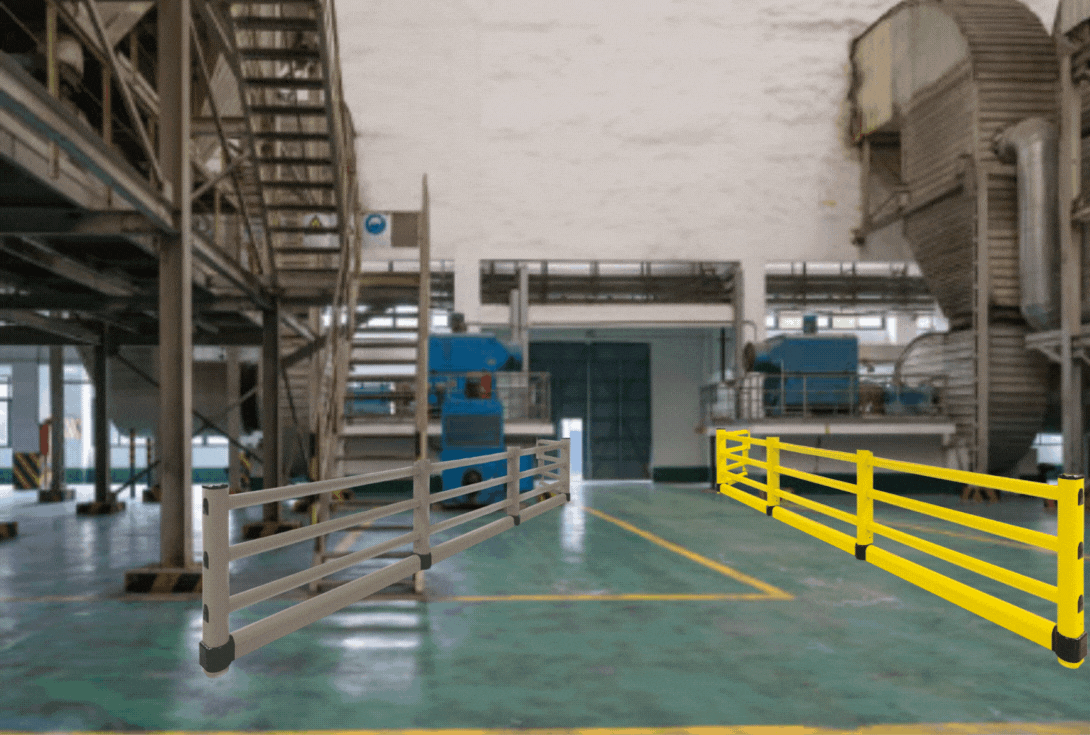Why are Polymer Safety Barriers yellow?
 By
Alana Graham
·
3 minute read
By
Alana Graham
·
3 minute read
When you start researching polymer barriers, it may be confusing to scroll through the different available options and be able to choose the correct barrier for your site. And why is there so much yellow? Are there any other colours to choose from? You want to find a solution as quickly as possible to comply with safety regulations, however you want to ensure you are not going to have to replace the barrier you choose in the next few years.
At Clarity, we often have customers ask us if we offer different colours of polymer barriers, so that it fits more with the aesthetic in their factory. We understand the challenge you may be facing, and want to address your issue as easily as possible.
In this article, we’re going to break down the main reasons why polymer barriers are yellow, some arguments for and against different colours, and how to choose the best colour for your environment.
Standing out in a sea of grey: The Visibility Advantage
One of the primary advantages of yellow safety barriers is their exceptional visibility. Yellow stands out prominently against different backgrounds, including busy construction sites, warehouses, and car parks. This high visibility ensures that safety barriers remain noticeable even in challenging conditions such as low lighting or bad weather. In contrast, colours like grey or black may blend into the surroundings, reducing their effectiveness in alerting individuals to potential hazards.
The high contrast provided by yellow safety barriers can also help improve the speed of hazard recognition, allowing workers to react quickly and respond appropriately in dangerous situations. This can ultimately reduce the likelihood of accidents and injuries in the workplace.
Why Yellow? The magic behind the colour choice
Yellow isn’t just a random colour choice – it’s a strategic decision rooted in psychology, hence why most of the flexible industrial barriers you will find, are yellow. Yellow is often associated with caution, attention, and alertness, making it an ideal choice for safety equipment. Research has shown that yellow is one of the most easily recognisable colours, especially in low-light conditions. When people see yellow, their brains automatically register caution, helping them to proceed with care. This innate psychological response helps to enhance safety awareness and prevent accidents in various work environments.
Yellow vs Grey vs Black
We understand that some customers may express preferences for alternative colours such as grey or black for safety barriers, so they are not so glaringly obvious, when you may want site visitors to focus on other areas of the factory. While these colours may offer a sleek aesthetic, it’s essential to consider the functionality and effectiveness of the barriers as safety equipment. Grey and black barriers, while visually appealing, often lack visibility in comparison to yellow barriers. It is important to consider the main objective of the safety barriers you would like to implement, which is likely based around protecting your people or your assets. In order to do that, you need to opt for a solution that has a high impact-resistance in the case of an accident and stands out the most visually to avoid having an impact in the first place. If you have a look at the image below, that should help to explain my point. Imagine driving through your warehouse drunk, although we hope that won’t be the case! When you blur the image, the first thing you should see is the yellow barrier, not the grey barrier.

Industry standards and regulations
The choice of yellow for safety barriers is not random – it’s supported by industry standards and regulations. Organisations such as the Health and Safety Executive (HSE) and the British Standards Institution (BSI) provide guidance on safety signage and equipment colours based on established best practices and international standards.
For example, the Health and Safety (Safety Signs and Signals) Regulations 1996 outline requirements for safety signs, including their colours and symbols. While not specifically addressing safety barriers, this regulation emphasizes the importance of using consistent colours and symbols to convey safety messages effectively.
Additionally, the British Standards BS EN ISO 3864-4:2011 provides recommendations for colourimetric and photometric properties of safety signs and signals. Adhering to these standards can help ensure that safety barriers are easily recognisable and effectively communicate hazards to workers and visitors.
Do other colours have benefits?
While yellow safety barriers offer distinct advantages in terms of visibility and psychological impact, it’s essential to consider whether other colours such as grey or black barriers have benefits that yellow ones don’t. Grey and black barriers may have a sleeker aesthetic that some customers prefer, especially in environments where visual harmony or brand consistency is a priority. Additionally, in certain settings where the contrast between the barrier and the background is less critical, such as indoor facilities with controlled lighting, grey or black barriers may blend in more seamlessly with the surroundings, providing a less obtrusive safety solution. However, its important to weight these potential aesthetic benefits against the proven effectiveness of yellow barriers in enhancing safety awareness and reducing the risk of accidents, particularly in dynamic or high-traffic environments.
Which colour is best for me?
Ultimately, the choice between yellow, grey, black or any other colour barriers should be guided by a comprehensive assessment of the specific needs and requirements of each site, prioritising both safety and aesthetics to achieve optimal outcomes. Technically, there is no right or wrong colour for your barriers, but at Clarity, we do recommend you opt for a yellow barrier purely for the visibility benefits. You can’t be too safe with safety!
At Clarity, we have helped many large businesses around the UK implement high-impact resistant barriers to create a showcase factory, where safety is the priority.
In order to quickly find a suitable solution for the barrier requirements at your site that complies with safety regulations, you can browse our range of barriers here, that are tested to the UNI/TR 11886 specification. Or if you are ready, click the image below to get your free quote.

